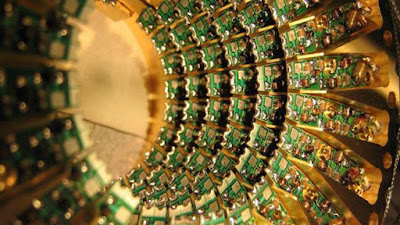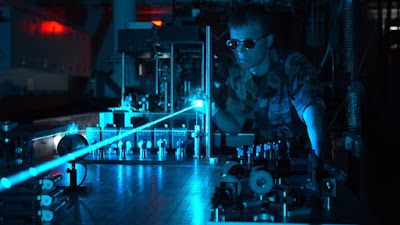The current population on earth is roughly 7 billion people
and is estimated to be close to 9.6 billion by 2050. India and China are experiencing
booming economies and as a result demand more raw resources to meet their
economic demands. All of this puts a considerable pressure on our environment
and manufacturing. On one hand we have booming demand and the other we have
increasingly scarcity of resources. It is a recipe for disaster, but there has
been theorized possibilities that may yield to what has been termed “Radical
Abundance.”
Radical Abundance by Eric Drexler, the man
that coined the term Nanotechnoloyg.
Eric Drexler Is a former aerospace scientist from MIT that helped coin the term Nanotechnology and has written several books on the subject. Drexler’s newest book Radical Abundance highlights some of the problems with our concept of Nanotechnology and its applications. As Drexler puts it, a funny thing happened on the way to the future, and what he means is that the nanotechnology of today is not what he initially envisioned when he coined the term Nanotechnology. Instead what we largely see as the field of Nanotechnology is main materials engineering. These materials have been in the form of coatings, structures and surfaces that either have increased wetability or varying thermal conductivity properties. Eric Drexler feels that there is more potential for Nanotechnology to solve our problems and to usher in a new age of Radical Abundance though a new term he has termed Atomically Precise Manufacturing or APM.
Liquipel is an example of how nanotechnoloy has
been used in materials science application.
Subtractive manufacturing yields lots of scrap and waste.
Additive manufacturing is an improvement, but APM will be near zero waste (Swee).
Additive manufacturing is an improvement, but APM will be near zero waste (Swee).
Drexler’s
vision of the future isn’t all rosy though and there are very significant
impacts that will occur as a result Atomically Precise Manufacturing. Drexler
compares the impact of APM to a combination of the Industrial Revolution
meeting the Digital Revolution. He anticipates factories will be decentralized,
manufacturing will be on-shored (brought back from overseas), and entire
industries will be born while others will be destroyed during the rapid
deployment of this new concept of manufacturing. Intellectual property laws will also be
greatly impacted, as knowledge and concepts will be shared at an exponential
rate. It is a form of economic destruction as products, manufacturing and
supply changes will look different post industrialized manufacturing.
"Many people, including myself, are quite queasy
about the consequences of this technology," ~ Eric Drexler
Part of Drexler’s theory indicates
that once the building blocks have been established the deployment and ability
to scale this technology across the globe will be rapid and expansive. In the
way that semiconductors started off slow and began to increase in advancement
following Moore’s Law, Drexler believes that APM will follow the same rise
after the concepts have been established and proven. As more factories and
engineers accept the concepts and put APM into work, more innovations will
occur leading to a second industrial revolution or the second machine age.
It’s not all gloom though as Drexler points out. Part of Radical Abundance and APM will ensure that you have more than ever before! At near zero cost to manufacture and with little impact on the environment the potential is endless. There is also immense commercial opportunity for the development and deployment of this technology which will take several decades to refine. Either way, the future of manufacturing will look nothing like the way that we manufacture today.
Resources:
It’s not all gloom though as Drexler points out. Part of Radical Abundance and APM will ensure that you have more than ever before! At near zero cost to manufacture and with little impact on the environment the potential is endless. There is also immense commercial opportunity for the development and deployment of this technology which will take several decades to refine. Either way, the future of manufacturing will look nothing like the way that we manufacture today.
Resources:
Drexler, Eric. “How Nanotechnology Will Deliver Radical Abundance." <https://www.youtube.com/watch?v=nqohcO1X9N0>.
YouTube. YouTube, 3 Jul. 2015. Web. 31 Oct. 2015.
Liquipel. “What is Liquipel? How does it work?." <https://www.youtube.com/watch?v=jedv15ov3sw>. YouTube. YouTube, 27 Oct. 2011. Web. 31 Oct. 2015.
Dr. Mak, Swee. “Future Manufacturing Trends - Enabling Technologies and Innovation." Hunter Research Foundation. Hunter Research Foundation, Jun. 2014. 31 Oct 2015. <http://www.slideshare.net/HVRF/dr-swee-mak-future-manufacturing-csiro-hrf-june-breakfast-2014>.
"How nanotechnology is changing our world." Foresight Institute. Foresight Institute.
Web. 31 Oct. 2015. <https://www.foresight.org/Updates/Update51/Update51.3.html>.
Liquipel. “What is Liquipel? How does it work?." <https://www.youtube.com/watch?v=jedv15ov3sw>. YouTube. YouTube, 27 Oct. 2011. Web. 31 Oct. 2015.
Dr. Mak, Swee. “Future Manufacturing Trends - Enabling Technologies and Innovation." Hunter Research Foundation. Hunter Research Foundation, Jun. 2014. 31 Oct 2015. <http://www.slideshare.net/HVRF/dr-swee-mak-future-manufacturing-csiro-hrf-june-breakfast-2014>.
"How nanotechnology is changing our world." Foresight Institute. Foresight Institute.
Web. 31 Oct. 2015. <https://www.foresight.org/Updates/Update51/Update51.3.html>.


















